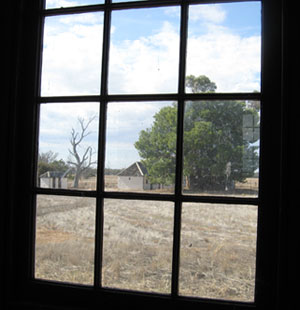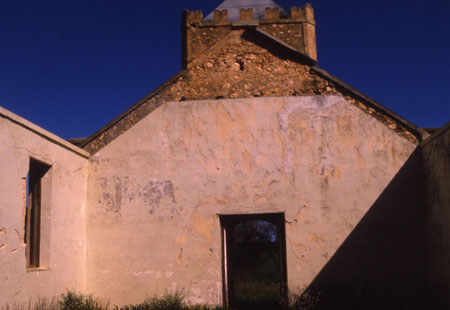In January 1859 both Aboriginal people and missionaries began clearing the Mallee scrub and native cypress from the site of the new mission station at Ebenezer, which meant “the rock of hope”. Situated on the vast, flat Wimmera region of Victoria, this area was one of the last to be settled by Europeans. It also saw its share of violence against the Aboriginal people. Innocent native blood had been spilt on the very site where Ebenezer was located.
Expressions of concern from sympathetic setters had alerted the London branch of the Moravian Missionaries to the plight of Australia’s indigenous people and they responded by sending their missionaries. The Moravian missionaries from Saxony, Germany, had chosen this site for the Ebenezer Station Mission the previous year. Although near the Wimmera River, the site was a traditional meeting place and corroboree ground and was safely located on a limestone rise. Its isolation was of paramount importance to the missionaries. They firmly believed that the mission had to be located far away from the influence of European settlement for any chance of future prosperity.
In August 1860 the first mission church was opened. It was made of pine logs, cut by the Aboriginals, and had a thatched roof. The bell that rang out from the church tower was a gift from Christian supporters in Saxony. At this opening service the baptism of the mission’s first Aboriginal convert, Nathanael Pepper, took place.
The mission church that now greets the visitor was opened in January 1875, replacing the original wooden church. Like the remaining, few buildings that stand at Ebenezer, it was constructed of local limestone. I first visited Ebenezer around midday on 25 April, Anzac Day, 2008. For the couple of hours that I wandered about, there were no other visitors.
With the declining number of residents at Ebenezer, the mission station was finally closed in 1904. The isolated location and the drought ravaged country side impressed upon me the hardships that must have been experienced on the mission when it was operational. The little cemetery behind the church with its scattered collection of headstones indicating where German missionaries and their families along with Aboriginal mission residents were buried further emphasized this. Aboriginal people continued to be buried in the Ebenezer cemetery after the station was officially closed.
On entering the church I was struck by the wonderful acoustics of this now empty building. I thought I would test them out and sang a couple of songs I had learnt as a child at Sunday school at North Sydney in the 1950s. Not having sung the songs, “Be valiant, be strong” and “My cup’s full and running over” for so long, I was surprised at the accuracy and confidence of my recall. It was only later, when I returned home, listened to a recording I made of my singing and read and reflected on the mission that I realized how appropriate my song choice had actually been.
At a time when many settlers regarded the indigenous population as not far removed from the wild animal and assumed their race was dying out, the missionaries at Ebenezer believed that Aboriginal people were a worthy part of humanity and had as much claim on the promises of Jesus as anyone else. The mission offered them protection from the lawlessness of the frontier. It was a place of spiritual as well as physical sustenance, a place of learning for their children and a place to freely come and go.
Many resided in buildings which they had constructed and, despite the poor quality of the mission land, ate vegetables and fruit they had grown themselves. From the missionaries’ viewpoint, their location of the mission away from the evils of the settled areas assisted the Aboriginal people in resisting “the power of sin”. If both missionaries and Aborigines remained “valiant and strong” they would be able to face the daily hardships on the mission with grateful hearts and truly claim that “their cup runs over”.
My contact with Ebenezer Mission Station made me want to know more about the place. Within two weeks of my visit I was reading Aldo Massola’s “Aboriginal Mission Stations of Victoria” and Robert Kenny’s “The Lamb Enters the Dreaming: Nathaneal Pepper and the Ruptured World”. Through these books I became acquainted with Horatio Ellerman and the dramatic events that changed his life, the tragic tale of young ‘William Wimmera’, the journey of missionaries like F.A.Hagenauer and Nathaneal Pepper’s experience bridging cultures.
In his book Robert Kenny claims that “to renovate a ruin is to deny the past as much as to recover it.” Even if the ruins are left alone, to him they are still “flawed witnesses.” That aside, I am grateful to have had the opportunity to wander the site and know that its story was being looked after in those sympathetically restored buildings. After all, it was those buildings that were the impetus for my beginning to find out more for myself. Their restoration would hopefully mean that another generation or more of Australians would also have the opportunity of discovering what happened there.
I came across some old coloured slides I had been given a number of years ago. They document a visit to Ebenezer, in 1988, some years before renovation was commenced around the turn of the century. The slides show the church without its roof and windows and the outside limestone walls are unpainted and in need of repair.
Visiting historical places like the Ebenezer Mission Station always reminds me how little of the past I will ever really know. But that has never hindered my enthusiasm for finding out more. Gaining any insight into the past requires an agility to sidestep prejudice, along with the unquestioning generalisations that blossom from a single, accepted anecdote and the often glib noise that rises from hindsight. That is not always easy and it requires a necessary discipline. But it can be very satisfying.
© Jim Low





